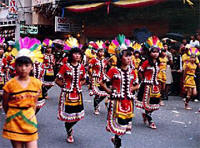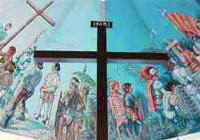�
About OutsourceIT2Philippines
- OIT2P has sealed its status in becoming the Philippine's premier Outsourcing Portal, providing foreign companies with easy access to the widest range of IT solution providers.
- The OIT2P team evaluates clients' businesses and identifies what kind of Internet presence they need.
- The OIT2P Management Team has significant professional management experience
- Our seven servers are located in two state-of-the-art data centers in Lansing, Michigan

�



Visayas
Geography
South of the island of Luzon, north of Mindanao and east of Palawan is the Visayas. The major islands in this group are Cebu, Bohol, Guimaras, Leyte, Panay, Negros, Romblon and Siquijor with many other little islands between them. Travellers will see and feel the island are different in topography, economic development, nature of the locals and even in the design of the tricycles
The Visayas, is the middle cluster of islands are characterized by natural and cultural diversity. The beaches of Boracay are regarded as some of the world�s best. In Boracay you will find most of the exotic Philippine hotels and resorts. Cebu is the cradle of Christianity and Bohol has one of the world�s most intriguing geological formations.
People and Culture
The people of Cebu are called Cebuanos and are descendants of Malay, Negritos, Spaniards, Mexicans and Chinese ancestries. Cebu is also home to a number of Spanish and Chinese communities who play an important economic and marketing role in the Cebuano society. Visayan - Cebuano culture is laid back and easy going; the people are friendly and has preserved strong Spanish-oriented traditions in its cultural life to this very day.
Dialect
Linguistically, Cebu is home to the country's second largest group. A derivative of Bisaya, the Visayan language, Cebuano was originally spoken only in the island of Cebu. However, it is now being spoken in many parts of Mindanao, the eastern part of Negros Island, the western and southern parts of Leyte, Bohol, and in Samar. The term Visayan came from an ancient Malay kingdom, called the Sri Vishayan Empire which ruled some parts of the Philippines in the 14th century to the early years of the Spanish conquest.
Religion
The patron saint of Cebu is the Santo Ni�o de Cebu, which is the image of the Child Jesus and housed in the country's oldest church, the Basilica Minore del Santo Ni�o. According to historical accounts, the Santo Ni�o was given by Ferdinand Magellan to the wife of the chief, Rajah Humabon as a gift to celebrate their alliance. That act is depicted in Cebu's largest, most popular cultural event, the Sinulog where street-dancing preceded by a holy mass is the main attraction.
Previously a part of the Archdiocese of Manila, Cebu was later made into a separate diocese, independent of the Manila archdiocese. It has several major churches, including the Basilica, the Cathedral, the San Carlos Church, the Sto. Rosario Parish Church, San Jose-Recoletos Church, Sacred Heart of Jesus, etc. as well as several other non-Catholic churches. Most of the population in Cebu are Roman Catholic (as in most Philippine provinces with the possible exception of Mindanao) though there are some thriving Muslim communities, most of whom are migrants from the islands of Mindanao.
Other religious minorities include Iglesia Ni Kristo, Jehovah's Witness, God's Kingdom, the Philippine Benevolent Missionaries Association, Church of Latter Day Saints, etc.

Population
In the Census of Population and Housing (Census 2000), Cebu City recorded a total population of 718,821 persons, 56,522 more compared to the 1995 Census of Population (POPCEN) results. Cebu City has one of the country's highest annual population growth rate, recording at 1.77 percent for the years 1995 to 2000. At the national level, the city shared 0.94 percent to the total population of 76.5 million as recorded in the Census 2000.
Economy
Cebu's economy is a hodgepodge of industries and commercial ventures. Recently, due to its burgeoning furniture-making industry, Cebu has been hailed as the furniture capital of the Philippines. The Department of Trade and Industry in Cebu is aiming to develop this aspect of Cebu economy by specifically targeting small to medium enterprises or SMEs whose products are considered export-quality. Cebu itself does not have a rich source of raw materials for furniture-making due to denudation of the forests, however, several the manufacturers are able to procure their materials from other islands and from imports as well. Cebu has two major economic zones located in Mactan - the Mactan Export Processing Zone I and II (MEPZ I & MEPZ II).
Besides furniture-making, Cebu is also fast becoming the IT capital of Southern Philippines. Many companies, either local or outsourced, are establishing their headquarters in Cebu. The city has become a site for various U.S. call centers and BPOs. The Cebu Chamber of Commerce and Industry, an organization comprised of Cebu's business elite, are centering the city's growth and economy on information and communications technology, with the aim of making it a premier ICT investment, software, and e-services hub in Southeast Asia.
History
The Magellan Expedition
On April 7, 1521, the Portuguese navigator Ferdinand Magellan landed on Cebu island. He was on expedition under the command of the Spanish king and his goal was to search for the fabled island of Moluccas and to see about expanding the Spanish territories to the Orient.
Magellan persuaded the Chief of Cebu, Rajah Humabon to swear oath and allegiance to the Spanish King Charles V . Accompanied by Spanish Dominican friars, the expedition was responsible for the first wave of Christianity in the Philippines. On April 14, Magellan erected a large wooden cross on the shores of Cebu where the first Holy Mass in the Philippines was also held. Afterwards, some 400 native Cebuanos were baptized, along with Rajah Humabon and his wife who took the Christian names Carlos and Juana, respectively to honor the Spanish King. The Santo Ni�o was also presented to the queen as a symbol of peace between the Spaniards and the natives.

Encouraged by his success in Cebu, Magellan later crossed the channel to the nearby island of Mactan which was under the rule of Muslim Datu Lapu-Lapu. On April 27, the historic Battle of Mactan occured where Magellan was killed and his men were driven off the island by the natives. According to historian and chronicler, Antonio Pigafetta, Magellan's body was never recovered despite efforts to trade for it with spice and jewels.
Magellan's second-in-command, Sebastian del Cano took his place and sailed the remainder of the fleet to Spain, taking a route different from the eastern route as opposed to the western route which they took when they first arrived. In so doing, the fleet became the first to "circumnavigate the world."
The Spanish Conquest
Survivors of the Magellan Expedition brought tales of a savage island in the Orient with them when they returned to Spain. Consequently, several follow-up expeditions were sent but all ended in failure.
Forty-four years after Magellan first set foot in Cebu, in 1565, conquistador Miguel L�pez de Legazpi and his 400 armed soldiers together with several Augustinian and Franciscan friars arrived and declared that the Spanish crown succeeded in colonizing the islands. Legazpi and his men then marched through Zugbo and bombarded the palisades of chieftain Rajah Tupas and destroyed the village. He later rebuilt it and called it Villa del Santisimo Nombre de Jes�s (Village of the Most Holy Name of Jesus). Thus, in 1569, it became the first Spanish settlement established by the Spanish Cortes in the Philippines.
On August 14, 1571, Cebu (Villa del Santisimo Nombre de Jes�s) was detached from the Catholic diocese of Manila and became a diocese of its own. When Legazpi departed for Manila in 1571, he did not abandon Cebu. Instead, he employed a state governor to look after it and left half of his men in Cebu.
Three centuries later, in June 12, 1898 marked the end of the Spanish era and the onset of the American regime. In 1901, Cebu became a municipality and on February 24, 1937 became a chartered city.
World War II
Cebu, being the most densely populated island in the country, served as a vital Japanese base during the Japanese occupation in World War II which began with the landing of the Japanese Imperial Army on April 1942. Three years later on March 1945, an American force landed and liberated the city from the Japanese.
Transportation
By sea
The Port of Cebu is the region's main gateway. There are also ports in Dumaguete in Negros Oriental, Tagbilaran in Bohol and Larena in Siquijor. Inter-island shipping is served by numerous shipping lines, two of them fastcraft companies which serve all the provinces in the region.
By air
The main airport is the Mactan-Cebu International Airport, which is in Cebu. There are also airports in Dumaguete (in Sibulan town), and in Tagbilaran. Tagbilaran airport is serviced by Asian Spirit, which flies to Cebu and Manila; Cebu Pacific and Philippine Airlines which flies only to Manila. Dumaguete is served by Air Philippines and Cebu Pacific, both of them flying only to Manila.
http://en.wikipedia.org/wiki/Visayas
Courtesy of travelpuppy.com
http://home.online.no/-erfalch/visayas.htm










